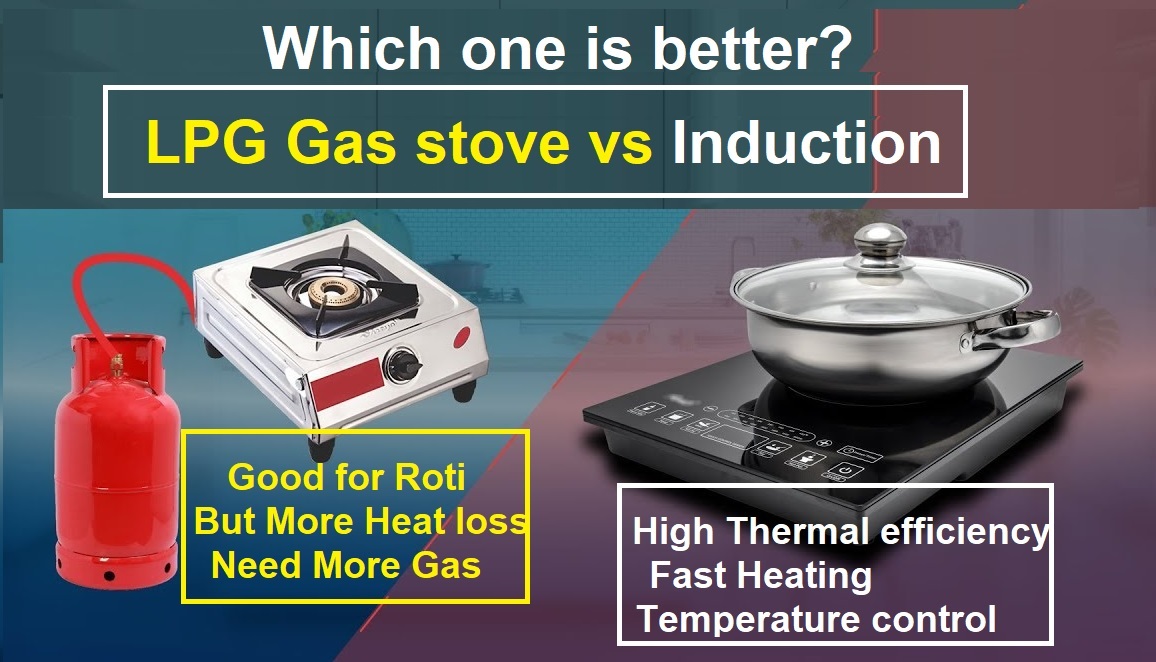Heat for Cooking
LPG Gas Stove
- The LPG gas stove burner is discussed in the previous post.
- An LPG gas stove is a kitchen appliance that uses LPG (Liquefied Petroleum Gas) as fuel to cook food. It typically consists of a burner, a gas regulator, and a control panel with knobs to adjust the flame intensity
- LPG gas stoves come in various sizes and designs, ranging from compact portable stoves for camping to larger ones with multiple burners for home or commercial use. They are popular because they are easy to use, efficient, and cost-effective.
- When using an LPG gas stove, it’s important to follow safety precautions to avoid accidents.
- Always ensure proper ventilation in the kitchen, keep the stove away from flammable materials, and turn off the gas supply when the stove is not in use. It’s also important to have the stove serviced regularly by a qualified technician to ensure it is in good working condition.

Know about Induction heating
- Induction heating is a process of heating a conductive material by using an electromagnetic field. It works by creating a magnetic field that induces eddy currents within the material, which in turn generates heat
- Induction heating is commonly used in industrial processes, such as in welding, forging, and heat treating of metals. It can also be found in consumer products like induction cooktops, which use the technology to heat cookware directly, without the need for a flame or electric heating element
- The process of induction heating involves several components, including an AC power source, a coil that generates the electromagnetic field, and a workpiece made of a conductive material. When the coil is energized with AC power, it generates a magnetic field around the workpiece. The magnetic field causes eddy currents to flow within the workpiece, generating heat
- The efficiency of induction heating is higher than other forms of heating because the energy is directly transferred to the material being heated, without the need for a heating element or a transfer medium like air or water. This results in faster heating times and more precise temperature control.
- Induction heating can be used with a wide range of materials, including metals, ceramics, and plastics. It is also a more environmentally friendly option, as it produces less waste and emissions than traditional heating methods.

Why Induction Heating is more efficient than Gas Stoves?
Induction heating is a highly energy-efficient method of heating, particularly when compared to other forms of heating like gas or electric heating. This is because it heats the material being heated directly rather than heating the air or surrounding environment.
Here are some reasons why induction heating is more energy-efficient:
Direct heating:
- Induction heating heats the material being heated directly at the base of the material only. It is in contrast to gas and electric heating,
- which first heats the air or surrounding environment before heating the material. This means that induction heating wastes less energy.
Rapid heating:
- Induction heating can heat materials much faster than other forms of heating, resulting in shorter heating times and less energy used.
Precise control of Temperature or Power Supply
- Induction heating allows for precise temperature control, which reduces the risk of overheating and energy waste.
Low Heat Losses
- Induction heating only heats the material being heated and not the surrounding environment. This means that there is no wasted heat that is lost to the surrounding environment.
Efficiency ratings
- Induction heating devices have high-efficiency ratings, typically ranging from 85% to 95%.
- Overall, induction heating is a highly energy-efficient method of heating that is increasingly being adopted in a variety of industries, including manufacturing, welding, and cooking.
The benefit of Induction over a gas stove
Induction cooktops have several benefits over gas stoves:
Energy Efficiency:
- Induction cooktops are more energy-efficient than gas stoves because they directly heat the cookware, rather than heating the surrounding air like gas stoves do.
- This means that induction cooktops can cook food faster while using less energy.
Precise Control of Temperature or Heat
- Induction cooktops offer precise temperature control, allowing you to adjust the temperature quickly and accurately
- You can choose a specific temperature, and the cooktop will maintain that temperature throughout the cooking process.
Safety
- Induction cooktops are safer than gas stoves because they don’t have an open flame.
- This means that there is no risk of gas leaks, fires, or burns.
- Additionally, induction cooktops only heat the cookware, not the surrounding surface, so there is less risk of accidental burns.
Easy to Clean:
- Induction cooktops are easy to clean because the surface doesn’t get hot enough to burn spills and splatter onto the cooktop. You can simply wipe the surface clean with a damp cloth.
Stylish and Modern
- Induction cooktops have a sleek and modern design that can add style to your kitchen.
- They are available in a variety of colors and finishes, so you can choose one that matches your kitchen décor.
Summary
- For LPG gas heating, the thermal efficiency is up to 70 to 80% due to more heating loss
- Induction cooking is more thermal efficient than LPG Gas stove
- Induction heating can reduce energy consumption by up to 70% :
- More than 90% of the energy produced is transferred to the pan itself
- Induction can cook faster using less power compared the LPG gas stove
- Induction is safer, as there is no flame or element to ignite fumes or cause burns
- Overall, induction heating is a powerful and efficient method of heating that has applications in a variety of industries and products.
